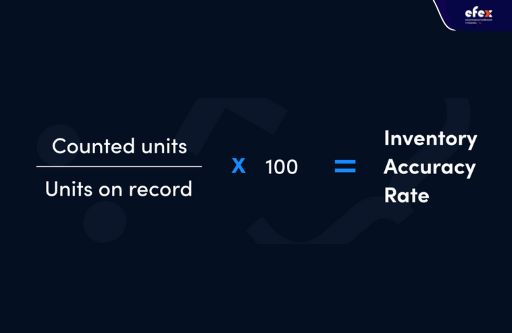
More Helpful Content
Possibly the most crucial statistic for industrial processes is inventory accuracy. The business won't be able to plan or predict, the supply chain will break down, expenses will increase, consumers will be dissatisfied, and the shop floor will have low productivity and efficiency. That's a big impact from a straightforward measurement, whose significance is sometimes overestimated. Let's investigate this vital production success indicator.
Inventory accuracy is a measurement of the discrepancy between your records of inventory and your actual inventory for purchase at a shop, warehouse, or storage facility is measured. For regulating inventory quality, reducing stockouts, shrinkage, and shortages, as well as ensuring a great customer experience, inventory accuracy is very important. Even though every firm would prefer to gain full inventory accuracy, it is difficult due to the simultaneous movement of goods.
👉 Read More: What Is Excess And Obsolete Inventory? Calculation And Analysis
👉 Read More: What Is The Difference Between Periodic And Perpetual Inventory Systems
Your supply chain might suffer greatly from even a small error. It's possible to sell a listed product that doesn't exist. Even if you are down to your final item, your records may still suggest that there is plenty of stock. At this time, inventory accuracy plays a key role. To maintain the highest level of inventory accuracy, the discrepancy between what is shown in the inventory management system and what is really present in your warehouse should be as little as possible
Regular counting and data reconciliation is necessary if you want to have any idea of how correct your data are. Compare these two:
You can count the physical inventory manually with two methods:
You can't assess the correctness of your records without the second dataset of manually checked inventory. Before using the formula below, you must collect the necessary data.
You must manually count the number of products in stock, divide that amount by the inventory count on file, and next multiply by 100 to determine inventory accuracy. The result is the accuracy rate of your inventory.
Inventory Accuracy Rate = (Counted Units/Units On Record) x 100

👉 Read More: What Is Centralized Inventory? Benefit And Drawback
👉 Read More: What Is In-Transit Inventory? Example And Formula
However, you must first establish that you have a trustworthy manual count to match your inventory data against before you can measure your inventory overall accuracy and apply this as a KPI. The count must adhere to the following requirements:
Inventory reconciliation, which involves comparing physical goods counts with records of inventory on hand, is another name for the determination of inventory correctness. All you have to do is personally count all of your current inventory, check it with your records, and then make any necessary adjustments. Your inventory is correct if the count you have matches your records.
You need to correct any differences if your count inventory doesn't match. There are two typical ways to determine inventory accuracy.
Inventory reconciliation or the practice of comparing actual inventory counts with inventories recorded aids in minimizing inventory discrepancies and determining their root causes. If you have a modest SKU number, order quantity, and overall unit count, this method is the simpler of the two.
Everything you must do is physically count every item you have on hand and compare the results to the inventory you should have. The accuracy and consistency of your inventory are confirmed if the two counts agree. If they don't line up, there is a clear disparity.
The easiest approach to make the most of this technique is to use it for weekly checkups. You can gradually maintain track of your goods in this way.
The amount of the inventory available (physical inventory) is divided by the amount of inventory you are intended to have in whichever system you use to manage inventory data. This approach for determining inventory correctness is a practice in inventory accounting.
Since you are not comparing every product in your inventory, this technique is less accurate. Check your sales record - keeping if your inventory accuracy is poor. This could make the disparity obvious.
As per the RFID Lab at Auburn University, businesses typically have inventory accuracy between 65 and 75 percent. This covers firms that employ barcode scanning and SKUs to manage inventories.
Naturally, this low percentage is bad for business. 97 percent or greater is the standard for most businesses looking to enhance overall inventory management.
Your inventory records must accurately reflect your real inventory in order to run a successful business and maximize your inventory. If not, you can encounter any of the below negative effects:
If your delivery is postponed by more than 2 days, up to 69 percent of your clients won't do business with you again. It can take weeks for a consumer to get their purchase if they place an order that is in the database not in the warehouse. Imagine how they will respond to a lot longer wait if 2 days is enough to lose the business. You might prevent situations like these by accurately counting your goods.
Additionally, it's likely that you have inventory that isn't listed anywhere. This inventory cannot be sold, so don't make any plans to relocate it. Product sales will be significantly slowed down as a result, and expired or ruined items may interfere with inventory control operations.
Another crucial operation that can be affected by inaccurate inventory counts is inventory prediction, which can then result in problems with order fulfillment and replenishment.
Bad records may frequently result in bad choices, such as making an excessive inventory purchase based on inaccurate consumption data. This will result in too much inventory, higher carrying costs, and a stockpile of unsalable goods in your warehouses.
Maintaining correct digital data is necessary for an inventory process to be effective. If not, it will be hard to effectively control your stock levels.
No matter the computation technique or technology you choose, maintaining a 100 percent inventory accuracy rate is nearly impossible. The average rate of inventory accuracy is typically 99.6 percent; the remaining 0.4 percent is primarily the result of human mistakes, which is unavoidable for big businesses.
The likelihood of an inventory data mismatch increases with the number of transactions, yet the occasional error is not caused for concern.
When it comes to boosting inventory accuracy, it is obvious that there are many ways. Here are a few excellent practices to take into account while attempting to increase accuracy in case any of these circumstances seem similar.

When mentioning inventory storage, organizing is key, and employing a few pallets and bins of conventional sizes helps keep the warehouse tidy. When you have different-sized bins on the same rack, it's simple for the smaller bins to get pushed behind bigger bins, which may go months without being seen.
Your inventory records during the period the bin is concealed can show a balancing act that your employees are unable to find, resulting in missed productivity or, worse still, dissatisfied clients.
Several warehouses use markers or pens to write product codes on boxes, which might lead to mistakes. Labels that are handwritten might be difficult to read. It's possible for the component number to be incorrectly written or for the carton to have been reused, both of which might lead to mislabeled items. Accuracy may be increased by putting in place a reliable barcode label printing program.
Labels must include both barcodes and human-readable numerals, and they must be big enough to be recognized from a picking point.
Many businesses start a cycle counting program, count 20 items, and then celebrate when 19 of them match the number of products they really have on hand. Yes, this may be said to have a 95% accuracy rate, but it could not. Verify the accuracy of the quantity as well as the places, batches, and labels. The main problem with cycle counting is that it is frequently misunderstood.
The goal is not to only fix the on-hand balance's mistakes and move on. Cycle counting is mostly used as a quality control method. To achieve the best cycle count results, it is suggested that these two particular segments be created:
The majority of e-commerce companies use barcode scanners to keep track of their inventory, loading the scanned data into inventory management software to prevent duplicate counting. Even though it's a sophisticated manual procedure, it's still considered a manual process. Radiofrequency identification (or RFID), which uses radio waves to manage inventory, is the method of inventory counting for the future.
RFID doesn't need to match with the UPC (or Universal Product Code) like typical barcode scanners do, enabling you to read a whole pallet of goods at once. As a result, fewer manual chores associated with classic scanners—such as rotating boxes to keep the line of sight—are required. Additionally, it aids in lowering labor expenditures, a significant operating expense.
Nevertheless, keep in mind that most e-commerce companies cannot afford the significant capital expenditure required by RFID.
You can collaborate with a fulfillment partner that can properly store and process your inventory by doing cycle counts as well as inventory audits, as opposed to handling the storage and delivery in-house. Firms that specialize in selecting, packaging, and delivering orders are called fulfillment businesses. You can also get thorough inventory statistics and important distribution metrics from a tech-savvy e-commerce order fulfillment provider like EFEX, which will help you keep precise track of your inventory.

Inventory accuracy is important in eCommerce order fulfillment. You may aim for 100% inventory accuracy now that you understand how to estimate it and how to increase it. It's critical to improve inventory accuracy and inventory management efficiency. This will assist you in maintaining total control over your inventory, enhancing the client experience, and minimizing leaks. It may, however, also be challenging and resource-intensive.
Thankfully, you can delegate all of this to an experienced third-party logistics company like EFEX. The order fulfillment services provided by Efex assist with inventory and order accuracy, warehouse receipt efficiency, warehouse picking enhancements, effective inventory management, and much more.


